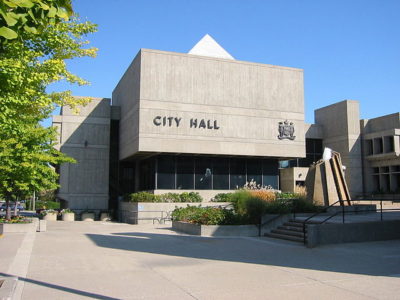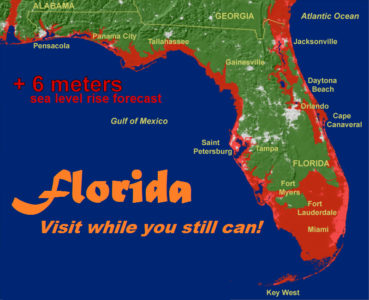All Eyes on the Subnationals
After the election of Trump, state and local leaders have to step up
As my colleague Ethan Elkind pointed out in a blog post the other day, the most viable path forward in the fight to slow (cause we’re kind of past the ability to prevent) climate change after the election of Donald Trump as President on Tuesday will be at the sub-federal level. As Ethan pointed out, there were always going to be limits to what we could accomplish at the national level – subnational governments (SNGs) like states, counties, and cities, were always going to be crucial in meeting emission reduction targets, no matter how hopeful the situation in Washington. My other colleague Nick Bryner detailed just how far we have to go even assuming perfect compliance with national commitments. After Tuesday, the role of SNGs went from necessary but supplementary to critical and, well, huge. Fortunately, action on the state and local level, both in the U.S. and globally, has been steadily gaining momentum and support.
In his post, Ethan mentioned the Under 2 Coalition founded by California in partnership with the Badem-Wurttemberg state of Germany. That Coalition has had immense success in bringing together leaders of subnational governments that are committed to reducing the impact of their regions on climate change. But the Under 2 Coalition is hardly the only organization of its kind. The C40 Cities Climate Leadership Group connects the mayors of more than 80 of the world’s major cities, representing over 600 million people and a quarter of the global economy. The U.S. Conference of Mayors Climate Protection Agreement, initiated in 2005, is a commitment by 1,060 mayors of cities large and small across the country to work toward meeting the goals of the Kyoto Protocol in their own communities and to urge their state and federal government colleagues to enact policies to reduce emissions. Although the agreement is not binding, the diverse list of signatory cities, including many in traditionally conservative states like Arkansas, Georgia, Montana, and Texas, does signal that climate change is not as politically fraught as we think at least at the local level. Many non-profit organizations have also added local and urban policy to their bailiwick, such as the World Resources Institute, which has created a global network focused on urban sustainability with offices in China, Brazil, India, Turkey, and Mexico.

All of this begs the question: “how much of a difference could small-scale, piecemeal action really make?” In fact, quite a bit. The world population is steadily becoming more urban, with half of people already living in cities, a proportion expected to grow to 70% by 2050. According to research done by C40, urban policy decisions taken before 2020 could determine up to a third of the emissions not already “locked-in” that make up the so-called “carbon budget” to stay under 2 degrees Celsius. How cities decide to build their infrastructure, therefore, could either be a major boon to meeting our emissions goals, or could undermine progress in other areas. Already, cities generate about 70% of global GHG emissions.Cities, particularly in growing nations like Mexico, Brazil, China, and India, are feeling mounting pressure from population growth to invest in infrastructure, optimize land use, and improve mobility. These priorities weigh in favor of investments and policies that also reduce greenhouse gas emissions, like mass transit and high density development.
States and local governments will also be (and in many cases already are) on the frontlines of preparing for and reacting to the impacts of climate change. In some U.S. cities, those impacts are beginning to shift the politics of taking action on adaptation, and even mitigation. At a 2016 public meeting of the Louisiana Coastal Protection and Restoration Authority, New Orleans Mayor Mitch Landrieu made a strident plea that state regulators acknowledge the role of humans in climate change and take action to slow it. He made a personal appeal to the Authority members, reminding them that, referring to the state’s quickly disappearing coastline, “if it ain’t there no more … you can’t put up hospitals, build roads, build playgrounds… You’re not going to have a place to work, not going to have a place to live.” He didn’t shy away from connecting sea level rise to human activity, either. “I know that its sacrilege to say the words ‘climate change’ in Louisiana,” he admitted, “but you know what? The climate’s changing and human actions are contributing to it. That is a scientific fact.” Almost exactly five months later, southern Louisiana suffered a 1,000-year flood, killing 13 people and damaging about 60,000 homes. The federal government continues to move the 100-year floodplain line, which determines which properties must carry flood insurance, so many people were caught off guard by the massive floods.
Although this latest flood is unlikely to drastically change the politics of global warming in that part of the country, local government leaders are starting to change their tone. And it’s not just big city mayors like Mayor Landrieu, either. The mayor of Central, a city of about 30,000, recognized that the frame of reference for major weather events like the flood is shifting, admitting that while he’d “love to be able to say this is a 1,000-year flood, this isn’t going to happen again,” there are “no assurances of that.” But recognizing shifting climate patterns and supporting efforts to reduce GHG emissions are two different things: “”I’m not about to say I’m a believer in global warming, but something’s going on with the weather. These phenomena are happening way too often.”
 This tension between the local reality of a changing climate and the polarized politics of doing something about it is playing out in a number of states across the country. Local leaders that have to find solutions for alarmed residents are starting to stray from party lines. Perhaps the most widely publicized example was the letter that fifteen Florida coastal mayors of both parties sent to Marco Rubio, requesting he meet with them so that they could explain the direct risks facing their cities as a result of climate change. Rubio, a Florida Senator who ran in the Republican presidential primary, had said that he did not believe that human activity “is causing these dramatic changes to our climate” or that “there are actions we can take today that would actually have an impact on what’s happening in our climate.” The mayors reminded him that sea level rise will be costly – the Southeast Florida Regional Climate Change Compact, a coalition of four county governments, estimated that a one-foot rise in sea level could do away with $4 billion of taxable real estate, a risk that grows to $31 billion if sea level rises three feet. But the state government, like Rubio, is unsympathetic to their situation: in 2015, it came to light that the Governor’s office had instituted an administration-wide ban on the very use of the phrases “climate change” and “sea-level rise,” instead only allowing references to “nuisance flooding.” These mayors are elected in some of the largest cities in Florida, including Miami, South Miami, and Fort Lauderdale, and in theory hold no small amount of power over the economic engines of the state.
This tension between the local reality of a changing climate and the polarized politics of doing something about it is playing out in a number of states across the country. Local leaders that have to find solutions for alarmed residents are starting to stray from party lines. Perhaps the most widely publicized example was the letter that fifteen Florida coastal mayors of both parties sent to Marco Rubio, requesting he meet with them so that they could explain the direct risks facing their cities as a result of climate change. Rubio, a Florida Senator who ran in the Republican presidential primary, had said that he did not believe that human activity “is causing these dramatic changes to our climate” or that “there are actions we can take today that would actually have an impact on what’s happening in our climate.” The mayors reminded him that sea level rise will be costly – the Southeast Florida Regional Climate Change Compact, a coalition of four county governments, estimated that a one-foot rise in sea level could do away with $4 billion of taxable real estate, a risk that grows to $31 billion if sea level rises three feet. But the state government, like Rubio, is unsympathetic to their situation: in 2015, it came to light that the Governor’s office had instituted an administration-wide ban on the very use of the phrases “climate change” and “sea-level rise,” instead only allowing references to “nuisance flooding.” These mayors are elected in some of the largest cities in Florida, including Miami, South Miami, and Fort Lauderdale, and in theory hold no small amount of power over the economic engines of the state.
Now is the time for subnational governments to leverage their immense economic and political power to maintain global momentum toward meaningfully reducing emissions. And they don’t and shouldn’t have to carry this burden alone – the private sector and civil organizations must play a major role. There is plenty left to do – it’s time for all hands on deck.






Reader Comments